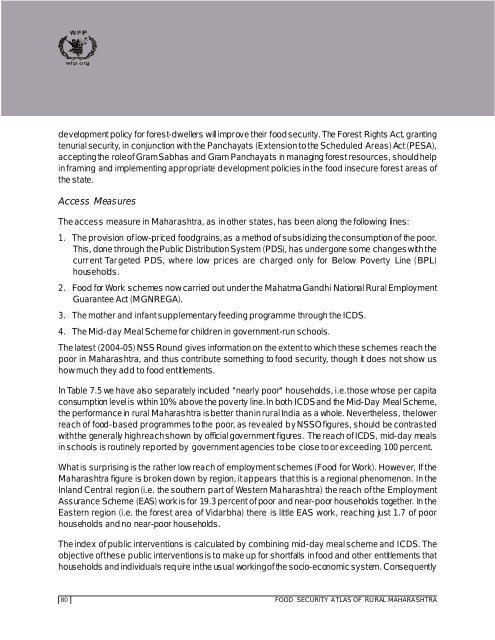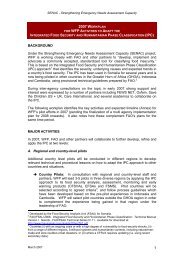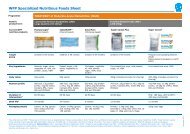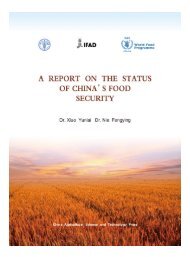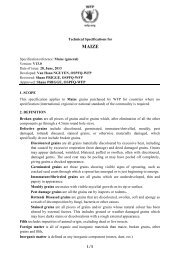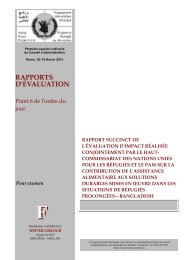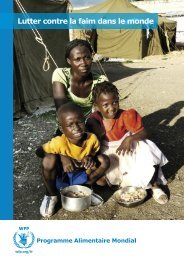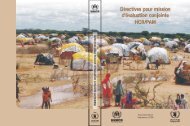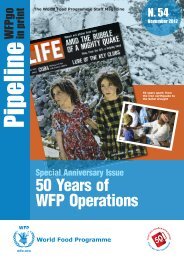5. There has been substantial increase in employment opportunities both in agricultural and nonagriculturalsectors in villages located close to the roads constructed under PMGSY.6. Substantial achievements have also been made on the health front. The frequency of healthworkers visiting the village has increased, as have institutional deliveries, and villagers have betteraccess to health facilities.7. The enrolment rate has increased due to better accessibility to educational institutions.8. An increase in land prices has been observed and many petty shops have come up on the roadside.Bharat Nirman: Rural RoadsBharat Nirman is a plan for action in rural infrastructure that started in 2005 and end in 2009. Underthe scheme, action is proposed in the areas of irrigation, roads, rural housing, rural water supply,rural electrification and rural telecommunication connectivity, in partnership with the state governmentsand the PRIs.As part of the programme, the government intends that by the end of the financial year 2008-2009,every village of over 1000 population, or over 500 in hilly and tribal areas, has an all-weather road. Toachieve the targets of Bharat Nirman, 146,185 kms of road length is proposed to be constructed by2009. This will benefit 66,802 unconnected eligible habitations in the country. To ensure full farm-tomarketconnectivity, it is also proposed to upgrade 194,132 kms of the existing associated through routes.To sum up, the keys to increase availability or production factors in Maharashtra are to increaseproduction and productivity in conditions of rainfed farming on hill slopes and in the Deccan plateau.The increase in production should also bring about an increase in incomes, thus also improving accessto food. Small scale irrigation, waters hed management, high value crops and impr ovedcommunications all have a role to play. In the Deccan plateau there is a need to diversify cash cropproduction so as to reduce dependence on just one crop, the price of which might vary substantiallyfrom year to year.7.3.2 Improving Access to <strong>Food</strong>A policy implication emerging from the indicators used for enhancing food security is the need forbetterment of the plight of the vulnerable populations, particularly the Scheduled Tribes and ScheduledCastes. It would be observed that like most other states, the tribal population in Maharashtra alsohas a close association with the forests. These Scheduled Tribes, particularly the primitive tribal groups,have faced a history of discrimination and due to their locational disadvantage, they have remaineddeprived of facilities. The Forest Rights Act seeks to address such groups (see Box 7.2). A properADDRESSING FOOD INSECURITY IN <strong>MAHARASHTRA</strong>79
development policy for forest-dwellers will improve their food security. The Forest Rights Act, grantingtenurial security, in conjunction with the Panchayats (Extension to the Scheduled Areas) Act (PESA),accepting the role of Gram Sabhas and Gram Panchayats in managing forest resources, should helpin framing and implementing appropriate development policies in the food insecure forest areas ofthe state.Access MeasuresThe access measure in Maharashtra, as in other states, has been along the following lines:1. The provision of low-priced foodgrains, as a method of subsidizing the consumption of the poor.This, done through the Public Distribution System (PDS), has undergone some changes with thecurr ent Tar geted PDS, where low prices are charged only for Below Poverty Line (BPL)households.2. <strong>Food</strong> for Work schemes now carried out under the Mahatma Gandhi National Rural EmploymentGuarantee Act (MGNREGA).3. The mother and infant supplementary feeding programme through the ICDS.4. The Mid-day Meal Scheme for children in government-run schools.The latest (2004-05) NSS Round gives information on the extent to which these schemes reach thepoor in Maharashtra, and thus contribute something to food security, though it does not show ushow much they add to food entitlements.In Table 7.5 we have also separately included "nearly poor" households, i.e. those whose per capitaconsumption level is within 10% above the poverty line. In both ICDS and the Mid-Day Meal Scheme,the performance in rural Maharashtra is better than in rural India as a whole. Nevertheless, the lowerreach of food-based programmes to the poor, as revealed by NSSO figures, should be contrastedwith the generally high reach shown by official government figures. The reach of ICDS, mid-day mealsin schools is routinely reported by government agencies to be close to or exceeding 100 percent.What is surprising is the rather low reach of employment schemes (<strong>Food</strong> for Work). However, If theMaharashtra figure is broken down by region, it appears that this is a regional phenomenon. In theInland Central region (i.e. the southern part of Western Maharashtra) the reach of the EmploymentAssurance Scheme (EAS) work is for 19.3 percent of poor and near-poor households together. In theEastern region (i.e. the forest area of Vidarbha) there is little EAS work, reaching just 1.7 of poorhouseholds and no near-poor households.The index of public interventions is calculated by combining mid-day meal scheme and ICDS. Theobjective of these public interventions is to make up for shortfalls in food and other entitlements thathouseholds and individuals require in the usual working of the socio-economic system. Consequently80 FOOD SECURITY ATLAS OF <strong>RURAL</strong> <strong>MAHARASHTRA</strong>
- Page 1 and 2:
Food Security AtlasOfRURAL MAHARASH
- Page 3 and 4:
Copyright © 2010The UN World Food
- Page 5 and 6:
TECHNICAL ADVISORY GROUPChairperson
- Page 8:
PrefaceIndia is home to more than a
- Page 12 and 13:
ContentsForewardPrefaceAcknowledgem
- Page 14 and 15:
List of Tables, Figures, Maps and B
- Page 16 and 17:
List of AbbreviationsADAPTAIDISAPLA
- Page 19 and 20:
Executive SummaryExecutive SummaryF
- Page 21 and 22:
capacities and knowledge.Measures t
- Page 24 and 25:
1. Introduction1. IntroductionIndia
- Page 26 and 27:
production. This portion of the con
- Page 28:
other states in the country. In lin
- Page 31 and 32:
Map 2.1: Maharashtra: Administrativ
- Page 33 and 34:
Table 2.2: Percentage Poverty Rates
- Page 35 and 36:
Table 2.6: Sectoral Composition of
- Page 37 and 38:
Table 2.8: Mortality and Nutritiona
- Page 39:
Table 2.11: Status of ConsumptionPe
- Page 42 and 43:
Children who are more than two stan
- Page 44 and 45:
Map 3.1: Food Security Outcome Map
- Page 46 and 47:
Table 3.3: Indicators used to Compu
- Page 48 and 49:
the ‘normal’ entitlements to fo
- Page 50 and 51:
to the dependent population 1 . Thi
- Page 52:
Table 3.4: Indicators Used to Analy
- Page 55 and 56: 4.2. ProductionTable 4.1: Growth of
- Page 57 and 58: Box 4.1: Agricultural Production an
- Page 59 and 60: Table 4.4: Extent of Irrigation in
- Page 61 and 62: The state has a modest coverage (15
- Page 63 and 64: Map 4.4: Status of Rural Connectivi
- Page 65 and 66: Table 4.8: Indicators Used in Const
- Page 68 and 69: 5. Access to Food5. Access to FoodT
- Page 70 and 71: Table 5.2: Rural Casual Wage Rate b
- Page 72 and 73: 5.3. Agricultural LabourersMaharash
- Page 74 and 75: Table 5.7: Proportion of Scheduled
- Page 76 and 77: Table 5.9: Ratio of Working Age Pop
- Page 78 and 79: Table 5.11: Rural Female Literacy b
- Page 80 and 81: poor food security situation. In Ma
- Page 82 and 83: Table 5.14: Urbanization in Maharas
- Page 84 and 85: This re gional patter n of migratio
- Page 87 and 88: 6. Food Absorption6. Food Absorptio
- Page 89: Map 6.1: Access to Health Services
- Page 92: Map 6.3: Food Absorption Map of Rur
- Page 95 and 96: Table 7.1: Ranks of Districts on Co
- Page 97 and 98: Map 7.2: Maharashtra: Priority Dist
- Page 99 and 100: e improved through better rural con
- Page 101 and 102: Box 7.1: National Policy for Farmer
- Page 103: A part of the wastelands has also b
- Page 107 and 108: Table 7.6: Index of Public Interven
- Page 109 and 110: Table 7.7: MGNREGS Performance, All
- Page 111 and 112: Another policy implication from the
- Page 113 and 114: The list of activities taken up und
- Page 115 and 116: Box 7.5: The Forest Rights ActThe S
- Page 117 and 118: women’s land rights also increase
- Page 119 and 120: Box 7.6: Ralegan Siddhi: A Village
- Page 121 and 122: may not be a corresponding improvem
- Page 123: Infants and Young ChildrenBox 7.8:
- Page 126 and 127: frequent disruption in the supply o
- Page 128 and 129: panchayats, the panchayats perform
- Page 130: Table 8.1: Key Interventions in Pri
- Page 133 and 134: Government of India (2007a), The Sc
- Page 135: Srivastava, Ravi, 1997, “Rural La
- Page 138 and 139: Thus, rights require state action w
- Page 140: obligation of the state to provide
- Page 143 and 144: Name of Variable and Description So
- Page 145 and 146: The basic objective of using PCA is
- Page 147 and 148: Appendix III: Index Value, Normativ
- Page 149 and 150: Table A3.3:Index Values and Normati
- Page 151: The Food Security Atlas of Rural Ma


